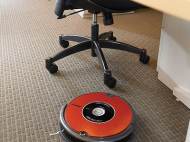iRobot vacuuming robot – Roomba
 A big majority of us actually keep our living quarters more or less clean. Roomba is a small floor vacuuming robot from iRobot which was introduced in 2002 and since then had several revisions and changes.
A big majority of us actually keep our living quarters more or less clean. Roomba is a small floor vacuuming robot from iRobot which was introduced in 2002 and since then had several revisions and changes.
The unit is a disc, 34cm in diameter and less than 9cm high. A large contact-sensing bumper is mounted on the front half of the unit, with an infrared sensor at its top front center. A carrying handle is fitted on the top of the unit. Depending on the model, it may come with between one and three “Virtual Wall” infrared transmitter units.
There have been three generations of Roomba units: The original Roomba, Pro, and Pro Elite; the second-generation “Discovery” series with a larger dustbin, dirt detection, and optional home base; and the newest 5xx series.
The Roomba operates with internal nickel-metal hydride batteries and must be recharged regularly from a wall plug, although newer second- and third-generation models have a self-charging home base they automatically try to find (via its infrared beacon). Charging on the home base takes about three hours. All second- and most third-generation Roombas can be used with the home base, even if they do not come packaged with it. First- and second-generation models came packaged with a twelve-hour charger, although a three-hour rapid charger could also be used with them.
Roomba picks up an amazing amount of dirt, dust, pet hair and other debris from your carpets and hard floors. Roomba automatically transitions from one floor surface to the next, including carpets, rugs, tile, linoleum and hardwood floors. Roomba’s compact shape allows it to vacuum beneath beds, couches and other hard-to-reach places while the innovative, spinning side brush removes accumulated debris along kickboards, cabinet edges and corners. It knows when it’s approaching stairs and other drop-offs, cleans up to the edge then automatically and safely changes direction to avoid going over edges.
Besides those features its bundles of fun for your pets and kids once they get used to it.
It also has a feature named Virtual Wall which creates an adjustable, invisible, infrared beam that Roomba will not cross. Virtual Walls are used to block off-limit areas in your home. A Virtual Wall Lighthouse can be set to Virtual Wall mode or Lighthouse mode. Lighthouse mode ensures the most efficient room-to-room cleaning: it confines Roomba to one room until that room is thoroughly vacuumed then directs Roomba to the next room. It can also be set to Virtual Wall mode to block off-limit areas. Virtual Wall Lighthouses are compatible with Roomba 500 Series robots (models 535 and up).
Newer Roomba’s or the ones with the Roomba OSMO//hacker contain an electronic and software interface that allows you to control or modify Roomba’s behavior and remotely monitor its sensors. The iRobot Roomba Open Interface, previously known as the Roomba Serial Command Interface, is intended for software programmers and robot constructors to create their own enhancements to Roomba. Various hardware interface devices are available to access the Roomba using the Roomba Open Interface and some projects are described on Roomba hacking sites. In response to this activity iRobot created the iRobot Create, which is a programmable robot of similar size and shape to the Roomba.
Newer models have a modular design which provides simpler cleaning, maintenance, part replacement and feature upgrades.









Leave your response!